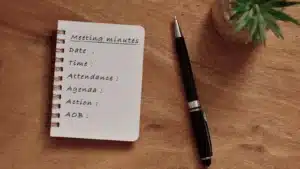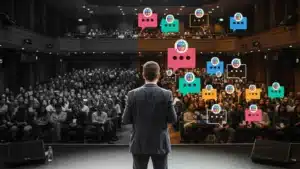
Meeting Minutes Examples That Make Recaps Simple and Useful
Meeting minutes serve as a vital record of discussions, decisions, and action items from any gathering. They not only provide a reference point for participants but also help those who were unable to attend stay informed. When crafted effectively, meeting minutes can enhance accountability and ensure that everyone is aligned on the next steps.
The Importance of Effective Meeting Minutes
In a fast-paced business environment, where time is of the essence, clear and concise meeting minutes can significantly improve productivity. They allow teams to quickly recall important discussions and decisions, minimizing the risk of miscommunication. Furthermore, well-documented minutes can serve as a legal record, protecting organizations from potential disputes.
What Makes Meeting Minutes Effective?
Effective meeting minutes should be clear, concise, and structured. They should capture essential information, including the date, time, attendees, agenda items, discussions, decisions made, and action items. By following a consistent format, teams can easily reference past meetings and track progress over time.
Utilizing tools that enhance engagement during meetings can also improve the quality of minutes. For instance, platforms that facilitate real-time audience interaction, such as PresEngage, can help ensure that all voices are heard and that important points are captured accurately. This not only enriches the content of the minutes but also fosters a culture of collaboration.
Moreover, the role of the minute-taker is crucial in this process. A skilled minute-taker not only captures the essence of discussions but also interprets the tone and context, which can be invaluable for future reference. They must be attentive, organized, and possess a good grasp of the subject matter to ensure that no critical information is overlooked. Training for minute-takers can further enhance the quality of meeting minutes, equipping them with techniques to summarize discussions effectively and highlight key points succinctly.
In addition, the distribution of meeting minutes should be timely and accessible. Sending out minutes shortly after the meeting ensures that the details are fresh in participants’ minds, allowing for immediate follow-up on action items. Utilizing cloud-based document sharing platforms can facilitate easy access to past minutes, enabling teams to maintain continuity and build on previous discussions. This practice not only reinforces accountability but also encourages a proactive approach to project management, as team members can readily revisit decisions and commitments made in prior meetings.
Examples of Meeting Minutes Formats
There are various formats for meeting minutes, each with its unique benefits. Choosing the right format depends on the type of meeting and the preferences of the organization. Below are some popular examples that can help streamline the process of creating effective meeting recaps.
1. Traditional Format
The traditional format is straightforward and often used in formal settings. It typically includes the following sections:
- Date and Time: The date and time of the meeting.
- Attendees: A list of participants and their roles.
- Agenda: The items discussed during the meeting.
- Minutes: A summary of discussions, decisions, and action items.
This format is beneficial for those who prefer a structured approach. It allows for easy navigation and reference, making it simple for attendees to find the information they need. Additionally, the traditional format serves as an official record that can be archived for future reference, which is particularly important for compliance and accountability in many organizations. By maintaining a consistent structure, teams can quickly familiarize themselves with the format, ensuring that all necessary information is captured and communicated effectively.
2. Action-Oriented Format
For teams that prioritize follow-ups and accountability, an action-oriented format can be particularly effective. This format focuses on outcomes and responsibilities, including:
- Action Items: Detailed descriptions of tasks assigned, along with responsible individuals and deadlines.
- Decisions Made: A summary of key decisions reached during the meeting.
- Next Steps: A brief outline of what needs to happen next.
This approach ensures that everyone is clear on their responsibilities and deadlines, reducing the likelihood of tasks falling through the cracks. Moreover, this format can foster a culture of accountability within the team, as individuals are more likely to take ownership of their assigned tasks when they are clearly outlined. Regularly reviewing action items in subsequent meetings can also enhance productivity and keep the team focused on their goals, making it easier to track progress and celebrate achievements along the way.
3. Visual Format
Incorporating visuals into meeting minutes can enhance engagement and retention. This format may include:
- Infographics: Visual representations of data discussed.
- Charts: Graphs to illustrate trends or outcomes.
- Images: Relevant pictures that help convey the message.
Utilizing a visual format can be particularly useful in creative industries or when presenting complex information. It caters to different learning styles and can make the minutes more memorable. Furthermore, visuals can help distill large amounts of information into digestible pieces, making it easier for attendees to grasp key concepts quickly. By presenting data in a visually appealing manner, organizations can also enhance collaboration, as team members may feel more inspired to contribute ideas and feedback when they can see the information represented in a dynamic way.
Best Practices for Writing Meeting Minutes
Writing effective meeting minutes requires attention to detail and a clear understanding of the meeting’s objectives. Here are some best practices to consider:
4. Prepare in Advance
Before the meeting, review the agenda and any relevant documents. Familiarizing yourself with the topics to be discussed will help you capture important points more effectively. Additionally, consider using tools that allow for real-time audience engagement, such as PresEngage, to ensure that all questions and insights are documented. This proactive approach not only aids in capturing the essence of discussions but also empowers participants to feel more involved, knowing their contributions will be acknowledged in the minutes.
5. Stay Objective and Concise
Meeting minutes should be factual and free of personal opinions. Focus on summarizing discussions and decisions without adding unnecessary details. Aim for clarity and brevity, ensuring that the minutes are easy to read and understand. It can be helpful to use bullet points or numbered lists to break down complex discussions into digestible parts. This format not only enhances readability but also allows for quick reference, making it easier for team members to locate specific information when needed.
6. Distribute Promptly
Timely distribution of meeting minutes is crucial for maintaining momentum. Aim to send out the minutes within 24 hours of the meeting. This ensures that participants can recall their discussions while the information is still fresh in their minds. Using automated tools can streamline this process, allowing for quick and efficient distribution. Furthermore, consider creating a shared online repository where all meeting minutes can be archived. This not only provides easy access to past discussions but also promotes transparency within the team, allowing new members to get up to speed quickly by reviewing historical context and decisions made.
7. Include Action Items
One of the most critical aspects of meeting minutes is documenting action items clearly. Each action item should specify who is responsible for the task and the deadline for completion. This not only holds individuals accountable but also ensures that everyone knows what is expected of them moving forward. Including a section dedicated to action items can serve as a quick reference for team members, making it easier to track progress and follow up on outstanding tasks in future meetings.
8. Review and Revise
After drafting the minutes, take the time to review and revise them for accuracy and completeness. It may be beneficial to have another attendee review the minutes to ensure that no important details were overlooked. This collaborative approach can help identify any discrepancies and enhance the overall quality of the documentation. Additionally, consider soliciting feedback on the format and content of the minutes from regular participants, as this can lead to improvements that better serve the team’s needs in future meetings.
Leveraging Technology for Enhanced Meeting Minutes
In today’s digital age, technology plays a significant role in improving the efficiency of meeting minutes. Various tools and platforms can assist in capturing, organizing, and distributing meeting notes effectively. The shift from traditional pen-and-paper methods to digital solutions not only saves time but also minimizes the risk of errors and omissions that can occur during manual note-taking.

9. AI-Powered Solutions
AI-powered platforms, such as PresEngage, offer innovative features that can transform the way meeting minutes are recorded. With real-time Q&A capabilities, presenters can address audience questions instantly, ensuring that all relevant points are captured during discussions. This not only enhances engagement but also provides a comprehensive record of the meeting. Additionally, advanced AI algorithms can analyze discussions to highlight key themes and action items, making it easier for participants to focus on what matters most. By automating the summarization process, these solutions free up valuable time for team members, allowing them to concentrate on strategic planning and decision-making.
10. SMS Engagement
Utilizing SMS for audience engagement allows participants to ask questions and provide feedback without the need for apps or downloads. This frictionless approach encourages more participation, leading to richer discussions and more thorough meeting minutes. The simplicity of texting ensures that everyone can contribute, regardless of their technical proficiency. Furthermore, SMS can be used to send reminders about upcoming meetings or to follow up on action items, ensuring that all participants remain engaged and accountable. This method not only fosters a sense of community among team members but also empowers them to voice their opinions and insights, which can lead to more informed decision-making.
11. Integration with Existing Tools
Many modern platforms offer seamless integration with popular tools such as CRM systems and project management software. This connectivity allows for automatic lead capture and follow-up, ensuring that action items are tracked and managed effectively. By leveraging these integrations, organizations can streamline their processes and enhance the overall efficiency of their meetings. For instance, integrating with project management tools can automatically assign tasks to team members based on discussions held during the meeting, which helps in maintaining momentum and accountability. Moreover, these integrations can provide valuable analytics and reporting features, enabling teams to assess the effectiveness of their meetings and make data-driven improvements over time.
Real-World Applications of Effective Meeting Minutes
Understanding how effective meeting minutes can be applied in real-world scenarios is essential for maximizing their impact. Here are some examples of how various industries can benefit:
12. Sales Teams
For sales teams, capturing meeting minutes can be critical for tracking leads and follow-ups. By documenting discussions with potential clients, sales professionals can ensure that they address all concerns and questions raised during meetings. Utilizing tools like PresEngage can enhance this process by automating lead capture and follow-up, allowing sales teams to focus on closing deals.
13. Educational Institutions
In educational settings, meeting minutes can help faculty and staff stay aligned on curriculum changes, policy updates, and student needs. By using a structured format that highlights action items, educators can ensure that important decisions are implemented effectively. Additionally, incorporating audience engagement tools can facilitate discussions, allowing for a more comprehensive understanding of the topics at hand.
14. Nonprofits and Community Organizations
Nonprofits often rely on volunteers and community members to drive their initiatives. Effective meeting minutes can help keep everyone informed and engaged. By documenting discussions and decisions, organizations can ensure that all members are aware of their roles and responsibilities. Utilizing SMS engagement can further enhance participation, making it easier for volunteers to contribute their thoughts and ideas.
Enhance Your Meetings with PresEngage
Meeting minutes are an essential component of effective communication and collaboration within any organization. By adopting best practices and leveraging technology, teams can create meeting recaps that are not only simple but also useful. Whether through traditional formats, action-oriented approaches, or visual representations, the key is to ensure that minutes are clear, concise, and actionable.
Ready to elevate your meeting experience? With PresEngage, you can transform your presentations into dynamic, engaging conversations that capture every participant’s input. Our AI-powered SMS Q&A platform ensures real-time interaction and seamless audience engagement, making every question count. Say goodbye to the hurdles of traditional Q&A sessions and hello to a world where every voice is heard and every point is captured. Start for FREE today and revolutionize the way you conduct meetings with PresEngage.
You Finish. Your Presentation Doesn't.
Dazzle your audience with Real-Time Q&A powered by your AI Co-Presenter.(Patent Pending)
PresEngage™ makes you look brilliant by connecting with everyone, instantly.
No Credit Card Required. 100% Risk Free.
Frictionless Audience Experience GUARANTEED.






